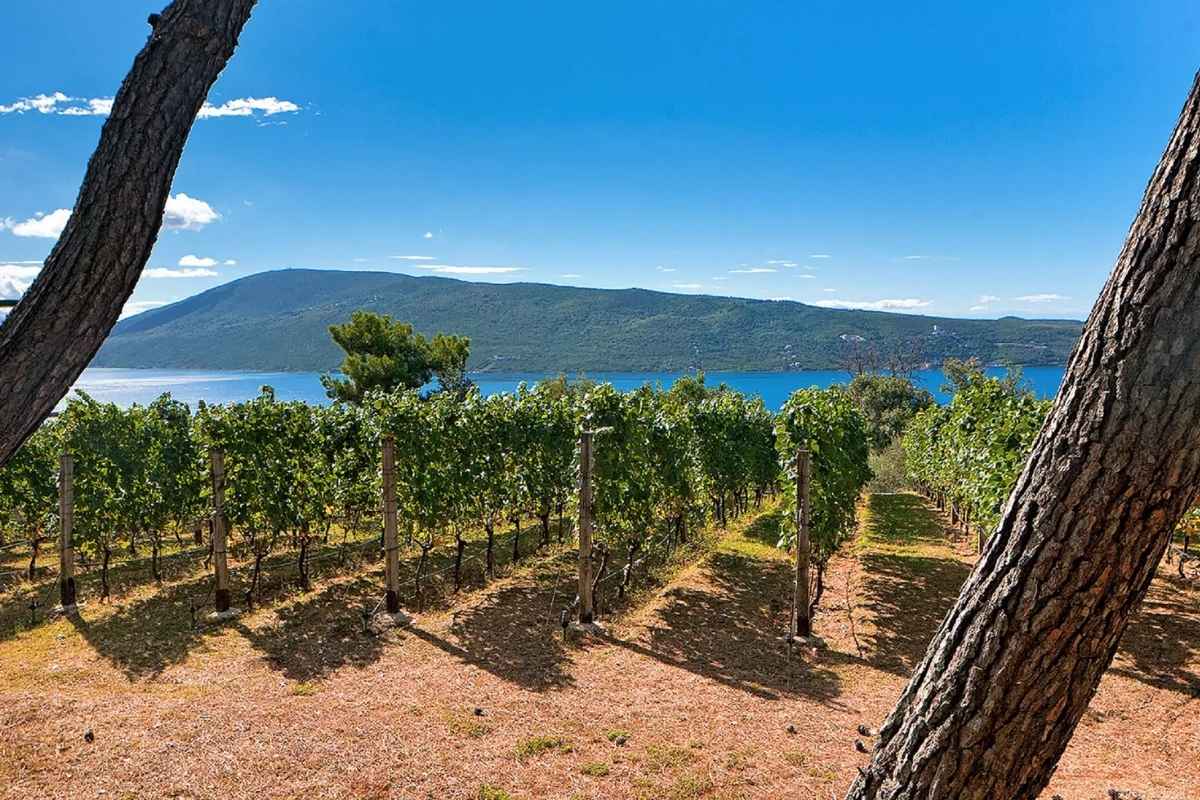Climate and vine growing conditions of the Montenegrin coast region
Average annual temperature is 14–16 ºC Mild winters, especially in lower coastal areas, allow for year-round viticulture. The Adriatic extends the growing season and provides steady winds, reducing disease pressure and supporting healthy vine development. The region is particularly favourable for later-ripening red varieties such as Vranac, Cabernet Sauvignon, and Merlot, as well as white varieties of the Sauvignon Blanc group in higher altitudes.
Grape varieties in the Montenegrin coast wine region
The leading grape variety of the Montenegrin Coast is Vranac, cultivated by around 80% of producers. The second most significant is Kratošija, grown by about 60% of producers. Together, these indigenous Balkan varieties form the backbone of red wine production in the region. Other important varieties include:
- Cabernet Sauvignon (7.69%)
- Chardonnay (7.69%)
- Smaller plantings of Merlot, Syrah, and other international grapes
The region also allows a wide range of permitted and recommended varieties for wines with geographical indication, including: Alicante Bouschet, Grenache, Gamay, Frankovka, Cabernet Franc, Lisičina, Muscat, Pinot Noir, Pinot Blanc, Pinot Gris, Riesling, Rkatsiteli, Sauvignon, Traminac, Žilavka, Žižak, Župljanka, and several newly developed domestic varieties.
Wine styles produced in Montenegro’s coastal wine region
Wines from the Montenegrin Coast are shaped by their Mediterranean terroir:
- Reds (Vranac, Cabernet Sauvignon, Merlot, Kratošija): Full-bodied, ripe, with deep colour, soft tannins, and a balance of fruit and spice.
- Whites (Chardonnay, Sauvignon Blanc, Krstač): Fresh, aromatic, with lively acidity and mineral undertones, especially from higher altitudes.
- Rosés: Crisp, elegant, and increasingly popular for summer consumption along the coast.
Among the most recognised wine labels from this region are:
- Montenegrin Coast Chardonnay (white)
- Montenegrin Coast Cabernet Sauvignon (red)
- Montenegrin Coast Merlot (red)
- Montenegrin Coast Vranac (red)
- Montenegrin Coast Rosé
The region also has a tradition of producing “young wine”, a style released as early as November 15 of the harvest year, available until March 31 of the following year, marked with the traditional expression on the label.
Wine subregions of the Montenegrin Coast
Boka Kotorska – Boka Bay
The largest subregion, covering 40.44% of the Montenegrin Coast, includes the municipalities of Herceg Novi, Kotor, and Tivat. Viticulture here benefits from the unique fjord-like Bay of Kotor, where Mediterranean warmth meets cool mountain influences.
- Leading varieties in Boka Bay wine subregion are Merlot, Vranac, Shiraz, Sauvignon Blanc, Kratošija, and Chardonnay
- The most common wine styles are balanced reds and aromatic whites, reflecting both international and local grape traditions
Budva–Bar
Accounting for 25.76% of the coastal region, Budva-Bar wine subregion covers the municipalities of Budva and Bar. Known for its dramatic landscapes and rich history (especially around Stari Bar), it has only a symbolic vineyard presence today but holds potential for development.
- Leading grape varieties are Vranac (dominant), Kratošija, Merlot, Riesling
- Wine styles that are most common in Budva-Bar wine subregion are Robust reds, with opportunities for fresher whites and rosés.
Ulcinj
Covering 29.63% of the coastal region, Ulcinj is the southernmost wine subregion and currently home to the largest vineyard surface within the Montenegrin Coast. The area is divided into northern and southern zones, with terroirs ranging from sandy coastal soils to limestone inland plots.
- Leading grape varieties that are grown in the Ulcinj wine subregion are Vranac (nearly half of the vineyard area)
- Other grape varieties grown in the Ulcinj wine subregion are Moldova, Cardinal (table grapes), and Sauvignon Blanc
- The most common wine styles are Full-bodied reds, with potential for boutique whites and integration into wine tourism
Adriatic Hinterland
The smallest subregion (4.17%), located at higher altitudes behind the coastal belt, covers parts of Herceg Novi, Kotor, Tivat, Budva, and Bar. Currently, there are no registered producers in Adriatic hinterland wine subregion, but historically, it hosted small vine plots.
- Potential varieties that can be grown in the Adriatic Hinterland wine subregion are Vranac, Kratošija, Cabernet Sauvignon, and aromatic whites
- A promising area for boutique viticulture and eco-tourism projects
9 wineries in the Montenegro coast wine region


